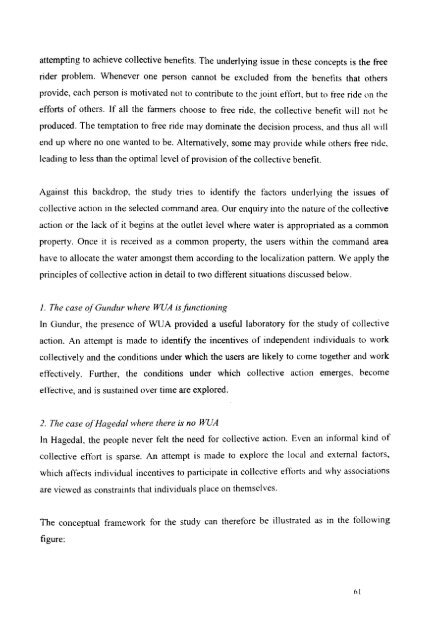Water Users Association and Irrigation Management - Institute for ...
Water Users Association and Irrigation Management - Institute for ...
Water Users Association and Irrigation Management - Institute for ...
You also want an ePaper? Increase the reach of your titles
YUMPU automatically turns print PDFs into web optimized ePapers that Google loves.
attempting to achieve collective benefits. The underlying issue in these concepts is the free<br />
rider problem. Whenever one person cannot be excluded from the benefits that others<br />
provide, cach person is motivated not to contribute to the joint ef<strong>for</strong>t, but to free ride on the<br />
ef<strong>for</strong>ts of others. If all the farmers choose to free ride, the collective benefit will not he<br />
produced. The temptation to free ride may dominate the decision process, <strong>and</strong> thus all will<br />
end up where no one wanted to be. Alternatively, some may provide while others free ride,<br />
leading to less than the optimal level of provision of the collective benefit.<br />
Against this backdrop, the study tries to identify the factors underlying the issues of<br />
collective action in the selected comm<strong>and</strong> area. Our enquiry into the nature of the collective<br />
action or the lack of it begins at the outlet level where water is appropriated as a common<br />
property. Once it is received as a common property, the users within the comm<strong>and</strong> area<br />
have to allocate the water amongst them according to the localization pattern. We apply the<br />
principles of collective action in detail to two different situations discussed below.<br />
1. The case of Gundur where WUA is functioning<br />
In Gundur, the presence of WUA provided a useful laboratory <strong>for</strong> the study of collective<br />
action. An attempt is made to identify the incentives of independent individuals to work<br />
collectively <strong>and</strong> the conditions under which the users are likely to come together <strong>and</strong> work<br />
etlectively. Further, the conditions under which collective action emerges, become<br />
etlective, <strong>and</strong> is sustained over time are explored.<br />
2. The case of Hagedal where there is no WUA<br />
In Hagedal, the people never felt the need <strong>for</strong> collective action. Even an in<strong>for</strong>mal kind of<br />
collective ef<strong>for</strong>t is sparse. An attempt is made to explore the local <strong>and</strong> external factors,<br />
which affects individual incentives to participate in collective etTorts <strong>and</strong> why associations<br />
are viewed as constraints that individuals place on themselves.<br />
The conceptual framework <strong>for</strong> the study can there<strong>for</strong>e be illustrated as in the following<br />
figure:<br />
hi
















